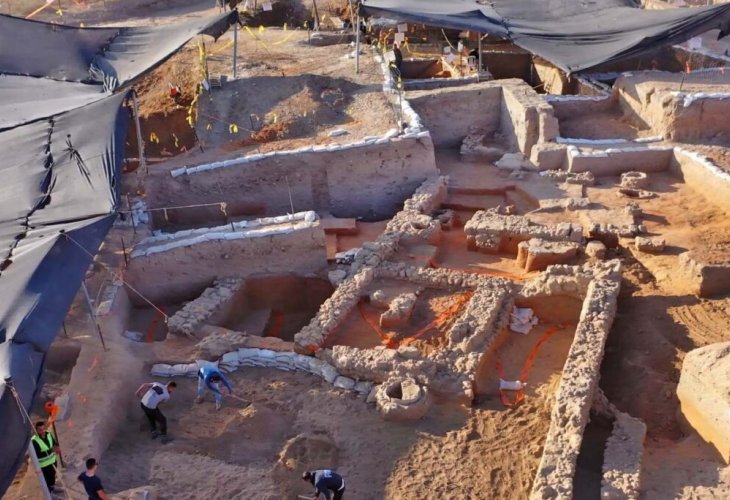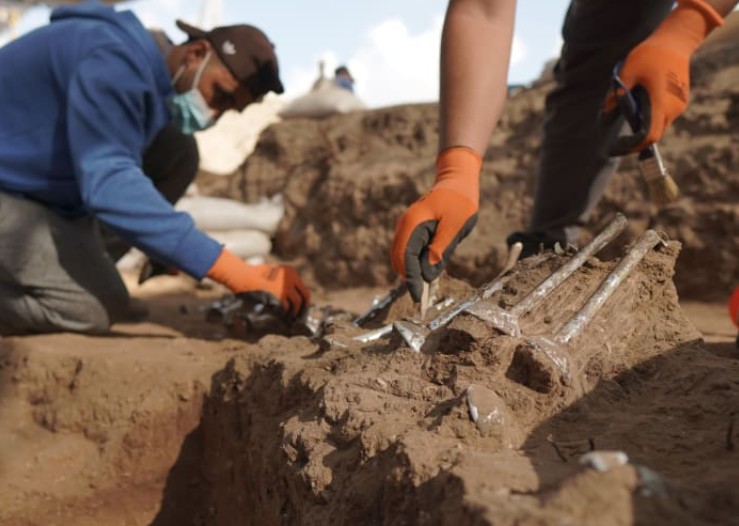Unveiling Ancient Yavne: Discovering Traces of the Sanhedrin
Archaeologists have unearthed a structure in Yavne, marked by limestone cups suggesting Jewish presence. Nearby, they encountered a large cemetery from the same era.
 Remnants of the Sanhedrin-era structure uncovered in Yavne (Photo: Yaniv Berman and Emil Algam, Israel Antiquities Authority)
Remnants of the Sanhedrin-era structure uncovered in Yavne (Photo: Yaniv Berman and Emil Algam, Israel Antiquities Authority)(Video: Yaniv Berman, Israel Antiquities Authority)
Recent excavations in Yavne have led to the first-time discovery of a structure dating back to the days of the Sanhedrin, the Jewish leadership around 2,000 years ago, which relocated to Yavne after the destruction of the Second Temple and Jerusalem. Inside the structure, archaeologists found limestone cups indicating a Jewish presence and adherence to purity laws.
Adjacent to the structure, a large cemetery from the same period was unearthed. Nearby, an extensive Byzantine-era wine production facility was also recently discovered.
"The discovery of artifacts from the Sanhedrin period is thrilling," say Pablo Betzer and Dr. Daniel Varga, excavation directors at the Israel Antiquities Authority. "This is a direct greeting from the era when Jewish leadership gathered the remnants after the Second Temple’s destruction, moved to Yavne, and began rebuilding the Jewish people."
During the excavation, the industrial-type structure was first revealed, dated between the 1st and 3rd centuries CE. The building's floor bore several fragments of stone vessels known as "measuring cups"—items that do not acquire impurity, associated with the Jewish population at the end of the Second Temple period and the second century CE.
The impressive cemetery was found just about 70 meters from the structure. "We discovered dozens of graves arranged in an extraordinary manner, in rows and regular intervals, suggesting the possible existence of a 'Chevra Kadisha'—an organization responsible for burials," say Betzer and Dr. Varga.
"The graves vary in form: some are sarcophagi, most made of stone, and one of lead. Due to the cemetery's location, it’s presumed to have been outside city limits, in line with Jewish law and Roman customs. But whether Jews or pagans were buried here is too early to confirm, since the graves lack ethnic identifiers. The historical narrative and archaeological findings cautiously suggest these might belong to Yavne's Jewish community. If correct, some graves may perhaps hold sages like Rabban Yochanan ben Zakkai, Rabbi Akiva, and Rabban Gamliel."
 Glass bottles discovered (Photo: Emil Algam, Israel Antiquities Authority)
Glass bottles discovered (Photo: Emil Algam, Israel Antiquities Authority)Another surprising find at the excavation included over 150 glass bottles, discovered placed atop the graves. Dr. Yael Gorin-Rosen, head of the glass division at the Israel Antiquities Authority, explains, "The bottles likely stored precious liquids like fragrant oils. Half were locally made, and the other half imported from Alexandria, Egypt. Such bottles are found in both Jewish and pagan graves from the 1st to the early 3rd centuries CE. The placement of the bottles outside the graves in Yavne, not within as was customary, remains a mystery."
In antiquity, Yavne was a key city in the southern coastal plain. During the Hasmonean period, it played a crucial role in the conflict between the Maccabees and the Seleucid (Greek) empire and is frequently mentioned in the writings of Josephus Flavius. By the end of the Second Temple period, Yavne was a mixed city, predominantly Jewish.
Talmudic literature describes how Rabban Yochanan ben Zakkai fled a besieged Jerusalem before the Second Temple's fall and persuaded Roman Emperor Vespasian to allow him to reestablish the Sanhedrin in Yavne. It was then that Rabban Yochanan ben Zakkai famously said: "Give me Yavne and its sages."
Between the Temple's destruction and the Bar Kokhba revolt, Yavne became the most significant Jewish spiritual center in Israel. Rabban Yochanan ben Zakkai, followed by Rabban Gamliel, led the Sanhedrin and the presidency in Yavne, restoring Torah life in the Land of Israel and instituting various ordinances.

